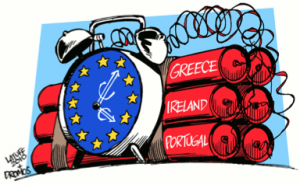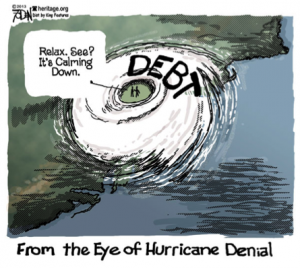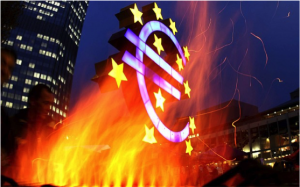Global Crisis waiting to explode:
The wonders of the modern financial world are unfolding before our eyes: borrowing from someone who has no money – charging it to someone else’s account – and pocketing a good part of the cash. Creating in the process a potential global crisis that’s waiting to explode right now. The world soon will see a wave of debt defaults that would cripple everything from large European banks to anyone with a saving account. According to the opinion of one of the world’s foremost experts on this topic, “we’re nearing the boiling point.”
 Since 2009, the US, EU, and Japan each of those have printed $4 trillion, that’s 12 trillion in added liquidity when combined with the money printed by the Bank of England, the People’s Bank of China, this amounts to $18 trillion, actually only helping to lift stock markets that are operating on investors’ behalf. This is authentic monetary inflation on an unprecedented and massive scale.
Since 2009, the US, EU, and Japan each of those have printed $4 trillion, that’s 12 trillion in added liquidity when combined with the money printed by the Bank of England, the People’s Bank of China, this amounts to $18 trillion, actually only helping to lift stock markets that are operating on investors’ behalf. This is authentic monetary inflation on an unprecedented and massive scale.
Corporate chiefs are borrowing more money to buy their own shares. They, more than anyone else, have figured out how to game the Central Banks system. They use the zero-interest-rate credit, to buy back their own shares. This pushes up the value of the remaining shares. Which leads for them to big, fat bonuses.
The ultra-low interest rates also signaled to producers that capital was plentiful and cheap. So, why not use it to produce oil? The oil-frackers borrowed about $500 billion and are using the money to drill holes all over the place. They hired people too. It is suggested that almost all new created jobs since 2008 were related to the energy boom.
With oil at $50 or less – and supply continuing to grow every month – what’s the future for the hundreds of billions of dollars that have been invested? What about real estate mortgages, and car loans? Retailers in almost every category are finding it impossible to compete with Amazon and other online retailers. – Amazon – which doesn’t make money couldn’t run its business if capital wasn’t free, but nevertheless is valued at over $100 billion! These are prime examples of how financial excesses can translate into real-world problems.
Now the price of oil collapsed under the pressure of too much new supply, undermining the industry’s profitability and calling into question the value of the reserves oil companies use as collateral for their debt. All of a sudden it looks like a lot of subprime energy debt is going bust. And that marks the end of the capital-spending boom that has been the highlight of the whole “recovery” myth.
Meanwhile, the dollar rises and foreign investors move their money into US stocks and bonds, seeking safety and capital return in a market, where the former is illusory, and the latter is fraudulent. Sooner or later Mr. Market will have his say. He always does.
Beneath the phony market created by artificial intervention, is a real market of real buyers and real sellers. At some point, the supply exceeds the demand. Then the smartest people in the business get worried. They quietly move toward the exit. Then the next smartest people notice that the geniuses have left – and they too, begin edging toward the exit. Then short sellers move in. Prices drop. And pretty soon, the market is in free-fall.
That is what always happens. “Bubbles always pop. It happened to the dot-coms, to houses, to subprime mortgage companies, to oil and to the oil-slick debt. We are now in what appears to be a boom cycle on Wall Street. It could last much longer… and go much further. Often, a boom of this magnitude needs an all-out, ‘barn-burning, super-duper final stage before it blows up’.”
The guess – just a guess – is that there will be another big scare before the final top of the equity bubble is achieved. – Expect a frightening fall – a quick reaction from the Central Banks – and then the great race to disaster will enter its ‘Last Looney Lap’.
Without more real income growth, the debt cannot be paid off. So, eventually it all will go bad. How can less earned money pay more money to service the debt that was supposed to lead to higher earnings?
You may ask the same question to the people who bought $500 billion of subprime debt from the energy sector, or those who bought $1 trillion of European periphery government debt. Or those who “invested” in $4 trillion of emerging market debt? The answer is everywhere the same: They cannot!
Debt to more Debt:
Almost every developed economy has followed the same path  – from debt to more debt. “The developed world added $50 trillion to its debt burden in the first eight years of the 21st century. This has pushed the debt-to-GDP ratio up from 260% to 390%.”
– from debt to more debt. “The developed world added $50 trillion to its debt burden in the first eight years of the 21st century. This has pushed the debt-to-GDP ratio up from 260% to 390%.”
“Households have tried to shuck the burden of so much debt. But government and corporations have borrowed more than ever. Now, the debt-to-GDP ratio is 415% – representing another $15 trillion. Logic, math and experience tell that an overburden of debt – unsupported by higher real earnings – will collapse onto the heads of the people beneath it. When? That’s the only question that cannot be answered now.”
But here is a survey of what can be expected in the coming months, as a consequence of above facts:
- “Between now and early 2017, the Dow will drop sharply to around 5,500 – 6,000, and could ultimately go as low as 3,300 – 3,800 before the next long-term bull market begins in 2020 or so.
- Unemployment will soar to 15% or higher as the work pool continues to shrink and companies lean towards employing people with experience, so no new comers.
- Housing prices will fall again, by as much as 40%… the so-called “recovery” of 2013/14 will diminish faster than expected as mortgage rates rise and the wrong group of investors – a.k.a. speculators – lose their taste for the market.
- With continued demographic decline, economic hardship and their budgets in crisis, more state and municipal governments will be forced into default, especially at the city and county level.
- Faced with huge revenue shortages, US Governments’ deficit will balloon from $1.3 trillion to as much as $3 trillion.
- The crisis in Europe will only get worse as the Spanish real estate bubble continues to burst, more banks in Portugal collapse, and each of the European Union member countries slips inexorably over the demographic cliff with the rapid decline of Germany as the biggest surprise.
- Despite the lessons learned in 2008, mortgage companies and financial institutions have resumed offering low interest no principle “teaser” loans, and increasingly risky investments, which will lead straight back into a second financial crisis, with no bailout possible this time.”
Research suggests the effects of these events will come to a head in 2015. Before that, “the market will tend to keep edging up. Many investors will make the mistake of thinking the recession is over – that the markets will continue to roar with life. All boom economies produced excesses, whether it be excessive homeowner spending and debt brought on by the misguided belief that housing prices will rise forever – or manufacturers who over build, over tool and over hire with the belief that his market will grow forever – or twenty and thirty-year olds making two, three and ten million dollars a year moving money on Wall Street.”
The greater the boom, the greater the excesses tend to be, and the longer it takes to shake them out of the system. And at roughly 30 years old, this latest boom has been the longest since the post-war economic revolution.
The Greatest Credit Bubble In Modern History Will Continue to Deleverage – Deflation, Not Inflation, Is Ahead. Here’s why deflation – not inflation – will be the order of the day, likely from around 2015 through 2023… especially into 2016.
History tells that most severe downturns and depressions have three phases.
- A severe crash, like we saw in late 2007 to early 2009, when the Dow fell 55%, from 14,280 down to 6,440.
- A market rally, spurred by renewed economic activity from government stimulus. That’s where we are now.
- And a final crash, deeper depression, and a deflationary phase that lasts for several years.
Most of us have experienced some kind deflation over the last few years, particularly regarding wages. Once credit bubbles go to extremes, they always burst and deflate – resulting in a sudden tightening of money supply (credit) – followed by deflation as massive amounts of debt are written off and financial wealth disappears as markets crash.
It happened in the 1930s. It happened again in Japan. Because no government can counteract that kind of overwhelming debt with any amount of stimulus without making its currency next to worthless, it’s likely to happen as this economic cycle continues to unfold. It’s believed markets will peak around 2015.
“Come mid-2015, we’ll see the risk of a next great crash accelerate… with the increased chance that the Dow will begin its slide to 6,000 by late 2016 or early 2017… and then likely as low as 3,300 by 2020 – 2022. We’ll see banks once again tighten up their purse strings and return to even more stringent loan policies than they implemented after the ’08 collapse.”
Final Chapter in the real estate market:
 It’s believed the world is about to see the final chapter of the biggest real estate shakeout in history. One of the classic rules of bubbles, history tells that these typically deflate at least back to where they started – and often a bit lower.
It’s believed the world is about to see the final chapter of the biggest real estate shakeout in history. One of the classic rules of bubbles, history tells that these typically deflate at least back to where they started – and often a bit lower.
That means, “housing prices will have to fall 55% to 65% from their 2005 highs. So far, they’ve only fallen 33%. That leaves another 22% to 32% still to disappear. Or 40% further to fall from these lower levels. Home values could fall back to the prices they were in 2000, or possibly as low as 1996 levels. That would put as many as half of the homes in “negative equity” – escalating default and foreclosure rates again.”
Together three economic truths, form the components of the perfect storm moving through the economy today:
- The last of the largest generation of spenders in history – the affluent Baby Boomers – are leaving their peak spending years behind them…
- Deflation will increasingly become the dominant trend as the economy slows and debts unravel…
- And the greatest housing “recovery” will begin to unwind again, leaving everyday homeowners wondering what hit them.
The impact of these three events all lead to one thing: A severe tightening of credit – and the write-off off tens of trillions in loans and entitlements. Which means less money in the system – less spending – less demand – falling prices – and ultimately: Depression and deflation.
Finally a reminder; I am merely reporting the realities of the current economy – and the likely path it will follow based on research of historical and empirical data. – To show that my report doesn’t stay alone, Richard Duncan formulates the global economy as follow:
“(It) is like a big rubber raft. Instead of being inflated with air, it’s inflated with credit. On top of the raft you have all the asset classes – stocks, bonds and commodities, including gold – and 7 billion people.
- The problem is the raft has now become fundamentally defective. So much credit has been created that the income of the 7 billion people is insufficient to service the interest on the debt… and they keep defaulting.
- When they default, the credit leaks outside of the raft. In other words, the raft is full of holes. And the credit keeps leaking out.
- There’s a fundamental flaw in the raft now. There’s too much credit relative to the income, at least in the way that world income is currently distributed.
- The natural tendency of the raft is to sink. And when it sinks – as it did in 2008… and when QE1 and QE2 ended – all asset classes go down together.
- Stocks go down… commodities go down… house prices go down, etc. People start to get their feet wet. And they start to panic.
- There’s only one possible policy response – and that’s to pump in more credit.
- That’s what the QE is about. Central banks pump in more credit. And when they do the raft reflates. Asset prices all go back up again… people have dry feet again… and they’re all happy again.
- What happens if policymakers completely cut off money printing now and don’t step in with some other policy, like more aggressive fiscal stimulus?
- The raft would sink just like it did in 1930. We would get sucked into a deflationary whirlpool… the international banking system would collapse… and global trade would collapse.”
The E.U. Falling Apart:
 Mario Draghi head of the ECB is doing “everything it takes,” and putting massive pressure on Germany to prop up all of the E.U. nations that limp along. However Europe is really stuck in a slow motion meltdown. The countries are mired in, or on the borderline of, recession. Deflationary pressures have brought the continent on the brink of collapse, and all sorts of ridiculous ideas like negative interest are implemented as life support. The risks for dissolution of the E.U. is still present, and will have profound implications for any country involved, regardless its role in the fiasco.
Mario Draghi head of the ECB is doing “everything it takes,” and putting massive pressure on Germany to prop up all of the E.U. nations that limp along. However Europe is really stuck in a slow motion meltdown. The countries are mired in, or on the borderline of, recession. Deflationary pressures have brought the continent on the brink of collapse, and all sorts of ridiculous ideas like negative interest are implemented as life support. The risks for dissolution of the E.U. is still present, and will have profound implications for any country involved, regardless its role in the fiasco.
Greece seems like old news; the fallout from the massive fraud uncovered years ago is still panning out. They vote in elections on January 25th, and polls are showing the opposition party Syriza is in the lead vehemently opposed against IMF and EU austerity requirements. This is prompting renewed fears that Greece will exit the euro and probably the E.U. Syriza is the party that oppose the oligarchs – the tycoons that sold the country out for a personal profit.
Greece’s anti-austerity SYRIZA party is leading in opinion polls now days ahead of a general election on Sunday. The country’s massive €317 billion debts remain a key point of disaccord among experts and politicians. Recent polls show SYRIZA is leading among voters and is three percent ahead of the ruling New Democracy party, according to a survey published in the To Vima newspaper on Sunday.
Should SYRIZA win the election, it will abandon austerity measures in favor of its own program to repay the national debt, said the party’s leader Alexis Tsipras in an interview with local Antenna TV channel.
Germany, long critical of the Greek impertinence following numerous bailouts, seems to be fine with it. The U.K. the other regional power is slowly spiraling towards leaving the E.U. altogether. This may be political saber rattling, but brinkmanship between bitter opponents doesn’t always find room for compromise.
France and Italy are failing to meet their obligations too, while Spain, Portugal and Ireland aren’t in much better shape. All of this is raising the specter of continent-wide contagion yet again, as the flaws of using a multinational currency persist.
Bonds and banks would immediately go haywire, and virtually everyone would have to eat losses during another massive credit crunch that would reverberate worldwide.
The US Dollar is deliberately being destroyed:
It is no secret the U.S. is the largest debtor in the world with all debt denominated in US Dollars, crashing it will be a victorious solution of the debt problem. Being unable paying off the debt it’s far more economical not to pay off, although countries holding U.S. debt will be very unhappy.
In the summer of 1971, before Nixon went off the pseudo Gold Standard, Treasury Secretary John Connally bluntly told a group of finance ministers who were complaining about the over sized US debt, already at that time:
“The Dollar may be our currency, but it is YOUR problem.”
The Gold Commission reported in 1982:
“If reasonable price stability and confidence in our currency are not restored in the years ahead, we believe that those who advocate an immediate return to gold will grow in numbers and political influence.”
But U.S. and World Debt have grown, as result of massive deficit spending programs that blew up all obligations. So there is no other way out of this misery as destroying the dollar!
Now, people know all the time the game has been rigged, while the Fed is deliberately ruining faith and confidence in the US Dollar, which is the end of the financial reserve system. Until people wakeup and ACKNOWLEDGE to what is happening the world will never being able to FINISH this ludicrous game.
Be wise and shift as much of your savings into gold as many others are doing this in a big way. People get scared, as ECB’s Mario Draghi will begin quantitative easing this week. Gold and silver are the last remaining safe-haven assets that haven’t been bid to the moon. Gold has become highly competitive with money in the bank. Central Banks can print more money, but they can’t print more gold. So when you’re given the choice between earning zero percent over the next five years in government-printed paper money, or earning zero-percent interest in a hard assets, like gold and silver that can’t be printed, holding precious metals is going to make a lot more sense nowadays.
Princes of the Yen: Central Banks and the Transformation of the Economy:
A prelude to exactly what is going on in the US and  Europe now, with the banksters Crime Cabal network of Rothschild Dynasty asserting global hegemony since at least 1780. The documentary, “Princes of the Yen” reveals how Japanese society was transformed to suit the agenda and desire of powerful interest groups – the Crime Cabal – and how citizens were kept entirely in the dark about this.
Europe now, with the banksters Crime Cabal network of Rothschild Dynasty asserting global hegemony since at least 1780. The documentary, “Princes of the Yen” reveals how Japanese society was transformed to suit the agenda and desire of powerful interest groups – the Crime Cabal – and how citizens were kept entirely in the dark about this.
Based on a book by Professor Richard Werner, a visiting researcher at the Bank of Japan during the 90s crash, during which the stock market dropped by 80% and house prices by up to 84%. This documentary uncovers the real cause of this extraordinary period in recent Japanese history.
Making extensive use of archival footage and TV appearances of Richard Werner from the time, the viewer is guided to a new understanding of what makes the world tick. And discovers that what happened in Japan almost 25 years ago, is again repeating itself in Europe. To understand how, why and by whom, watch this instructive documentary.
“Princes of the Yen” is an unprecedented challenge to today’s dominant ideological belief system, and the control levers that underpin it. Piece by piece, reality is deconstructed to reveal the world as it is, not as those in power would like us to believe that it is.
“Because only power that is hidden is power that endures.”
January 23, 2015 at 3:47 PM
Governments and central Bankers are liars.
The Swiss National Bank (SNB) told the citizens to vote against the referendum requiring an informal link of the Swiss Franc to gold on the 25th of November last, with argument it would cause them to break the peg of the Swiss Franc to the Euro.
The people believed them and voted “no”. Less than two months later, the SNB broke the peg anyway. With the result the price of gold is spiking, so the Swiss citizens have lost the benefit of that the referendum as it now is non valid. The SNB lied about their intentions with regard to the peg to the people.
The lesson of history is that citizens should own some gold, store it safely, and don’t believe government and central bank lies. In fact, more investors may flee to the safety of gold and silver in the coming months as trust wanes in central bankers.
The ECB’s latest gambit is coming on the heels of several other central bank surprises, such as the Swiss shocker, Canadian Central bank, Denmark’s central bank, and now the ECB. Who is next?
Apparently these central bankers have NO IDEA what to do! They’re throwing everything at the wall to see what sticks, with increasing frequency. They’re not even coordinating those moves anymore. It’s an all-out banker brawl, with investors like you caught in the middle. This is becoming a very dangerous volatile situation. Please keep your safety belts on, as the world is diving into an unknown abyss.
January 27, 2015 at 12:51 AM
You’ve got it again Peter. We all know what sticks to the walls once it’s hit the fans. And you must be psychic — The Greek election has thrown the EU into turmoil.
January 27, 2015 at 9:53 AM
Thanks Barbara step by step more is being discovered about the cruel governance of the world. Stay tuned.